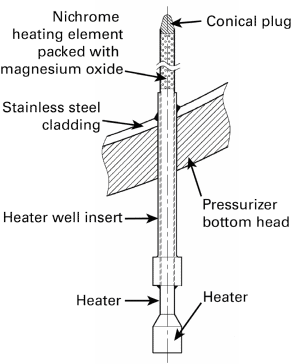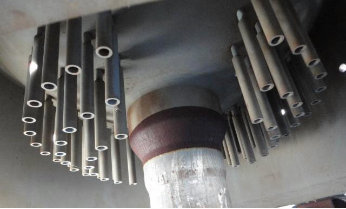Background
In 2010, an international plant was shut down due to primary coolant leakage from a service-induced crack in a deformed pressurizer heater well insert (HWI). Intergranular stress corrosion cracking had initiated on the outside diameter surfaces of the heater sheaths, allowing primary water to enter the heater elements. The primary water then reacted with the magnesium oxide insulation inside of the heater internals, resulting in volume increase and subsequent splitting of the heater sheaths and HWIs.
Description

Schematic showing heater, heater well insert and pressurizer bottom configuration
All plants can be affected by failed pressurizer heaters. Therefore, Westinghouse recommends (via Technical Bulletin TB-11-8, Revision 1) that all non-functional pressurizer heaters be removed and replaced at the next convenient opportunity.
Westinghouse can provide the engineering, design, analysis, and existing heater removal and new heater installation using specialty welding techniques for a simplified replacement of failed pressurizer heaters during routine outages.
The replacement of heaters is typically a straight forward process; however, service-induced anomalies (e.g., distorted, split or stuck heaters) may complicate the heater removal process, and therefore, contingency plans should be considered. On a case-by-case basis, Westinghouse will work closely with customers to define the right scope to meet their needs.
Base Scope: Replacement of Failed Heater
Westinghouse will design and analyze the processes for removing existing heaters and installing replacement heaters. In addition, Westinghouse will develop the necessary requirements for the replacement process (e.g., mechanical, electrical, welding and non-destructive examination [NDE]).
Westinghouse offers the following for a typical base scope:
- Administration and headquarters preparation
- Development of design
- Equipment testing and qualification
- Development of field procedures
- Crew training and qualification
- Mobilization of crew and equipment
- Materials (e.g., weld wire and welding consumables)
Westinghouse will use pressurizer design and installation information to adapt an existing pressurizer lower head assembly (complete with HWIs) to prototypically represent expected physical field conditions. Westinghouse’s existing pressurizer lower head mock-ups are located at its Lake Bluff, Illinois (USA), and Madison, Pennsylvania (USA), facilities.
The mock-up will be used to:
- Define/improve installation techniques with the aim to minimize radiation exposure
- Qualify tooling for heater removal and installation
- Qualify the welding process to be used for heater installation
- Train and qualify the crew
- Perform demonstrations (as needed)

Westinghouse pressurizer lower head mock-up
Contingency Scope
Contingencies can address potential anomalous conditions and include:
- Visual inspections of stuck heater (performed internal to the pressurizer)
- Calculate maximum removal/installation forces for the removal of stuck heaters to avoid damaging the HWI and its welded joint to the cladding on the inside diameter of the lower head
- Drilling out of the magnesium oxide inside stuck heater to aid in removal or to minimize the risk of future swelling of heater sheaths
- The design, analytical qualification and installation of plugs/caps to remove HWIs from service
- Analysis of existing conditions of stuck heater to justify continued plant operation
For any of the previous contingencies, the following additional activities may be required:
- Generation of engineering drawings
- ASME Code analysis
- Licensing documentation to support plant re-start
- Hardware procurement
- Weld wire procurement
- Generation of field procedures
- Qualification of field processes and tooling
- Crew training



